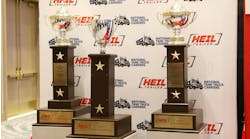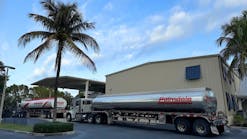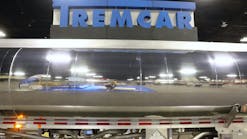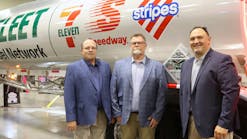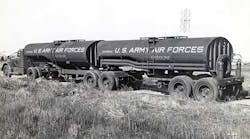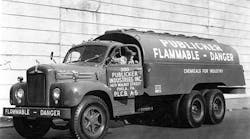An army might move on its stomach, but everything else runs on oil
PRIOR to the World War II, ocean tankers moved over 95% of the oil shipped to the East Coast from the Gulf Coast. That supply link was seriously disrupted by German U-boats which found the slow moving tankers an easy target.
The demand for alternative means of petroleum transportation utilizing rail, truck, and pipelines was met through the combined efforts of government and industry. Transportation was never nationalized, and intense intermodal competition was sidelined.
Much has been written about how the oil and railroad industries adapted to wartime distribution. This history examines the role of tank truck transportation in support of the nation and the war effort.
The day after Japan attacked Pearl Harbor, two government agents knocked on the door of Sam Niness who was vacationing with his family in the Pennsylvania Mountains. Niness was told to prepare immediately for a flight to Washington DC to meet with Secretary of the Interior Harold Ickes to discuss tank truck petroleum transportation.
Niness, then vice-president of Leaman Transportation Company of Downingtown, Pennsylvania, was to spend the rest of the war in Washington DC, where he served first as the Chief of the Petroleum Motor Carriers Section of the Office of Defense Transportation (ODT) and later in 1943, as the importance of tank truck transportation became more critical, as Associate Director of the Tank Truck Section of Petroleum and Other Liquids Transport.
Prior to the outbreak of World War II, the tank truck industry was made up of both private and common carrier fleets focused on short-haul movements of petroleum products. Ironically, the small tank truck industry was called on to provide relief to its most significant competitor, the railroads, so tankcars could be dedicated to long-haul movement of oil to both coasts.
Niness, his assistant C Austin Sutherland, publisher of Petroleum Transporter magazine (which later became Bulk Transporter), and many other experienced tank truck executives tackled the objective of ensuring maximum utilization of tank transport to meet civilian and military needs. ODT Tank Truck Committees were appointed in every state with most committees chaired by tank truck company executives.
The tank truck industry faced both regulatory and resource challenges in adjusting to its wartime role as the primary domestic distributor of petroleum products to citizens and to the various industries that required petroleum products to produce goods and services to support the war effort. Oil transports ran around the clock to provide aviation fuel to airfields not served by rail. The regulatory challenges were met in part because Interstate Commerce Commissioner Joseph B Eastman served as Director of the Office of Defense Transportation from December 18, 1941 until his death in March 1944.
Longstanding regulations were modified to allow maximum utilization of tank trucks. Perhaps the most important rule was ODT Directive #7 which provided that tank trucks be used in petroleum movements of less than 200 miles. This freed up the aging rail tankcar fleet to move oil longer distances. One estimate reported by the Petroleum Administration for War was that one truck transport released an average of seven tankcars from short-haul service.
Tank trucks were at the top of the list of materials approved for construction from precious metals such as steel and aluminum and, perhaps more importantly, for tires. Most rubber suppliers were under control of Japan and synthetic rubber was still under development. The War Production Board controlled who could purchase a new truck or trailer.
Truck mechanics were charged with getting the most out of equipment and tires. Eventually, the standard 2,000-gallon tank trailer was increased in size up to 8,000 gallons and states were urged to waive size and weight laws. On the human side, tank truck drivers were eligible for deferments as their skills were needed to move petroleum.
The petroleum industry, from exploration to refining to distribution, helped win the Second World War. Skillful adaptation of the tank truck as a tool of oil transportation contributed to that success.
At war’s end, the Army-Navy Petroleum Board of the Joint Chiefs of Staff said: “At no time did the Services lack for oil in the proper quantities, in the proper kinds, and in the proper places.” ♦
This is an excerpt from History of the Tank Truck Industry, which is being written by John Conley, retired president of National Tank Truck Carriers and former editor of Bulk Transporter magazine. Conley has asked for help in locating pictures/information on trucking companies and equipment operated during the 1900s into the 1950s.
The early years of the industry were “rough and tumble” as tank trucks competed with the railroads and advances in tank truck design moved the distribution of milk and other products from smaller containers to bulk. The Motor Carrier Act of 1935 brought some order to the trucking industry and the tank truck industry came of age during World War II. The tank truck industry played a key role in helping supply petroleum products in support of overseas operations and domestically by freeing up railroad tank cars to move oil to both coasts from the Gulf states.
Conley is looking for photos of typical tank trucks operated on the home front during the war. Any materials can be returned. The book is scheduled for publication in April 2015.
Photos and other materials can be sent to John Conley, 142 Evelyne St, Chester, Maryland 21619. He can be contacted at [email protected] or (703) 216-0449.
